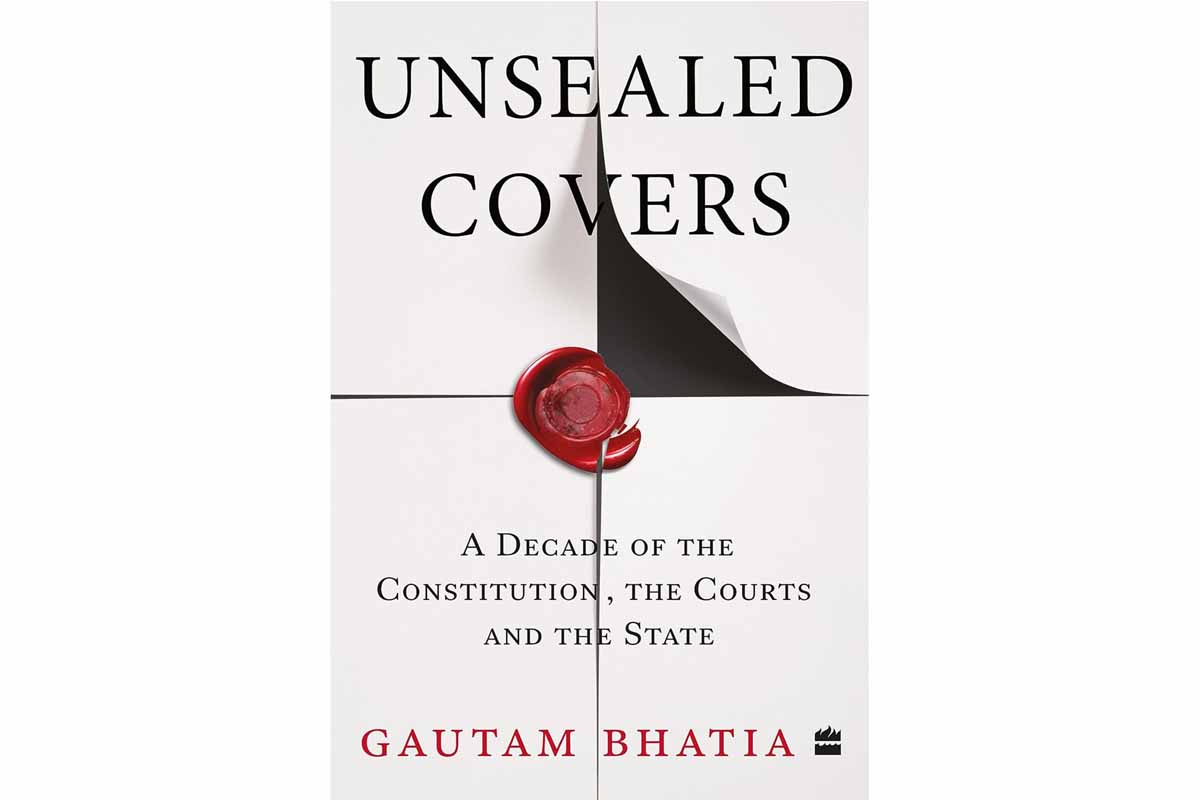As ink meets parchment in the realm of law, the wise words of philosophers and the weighty tomes of jurisprudence from our law school days beckon. To commence this review without a nod to their sagacity would be a misdemeanour.
For Jean-Jacques Rousseau, liberty is at the root of being human. For John Locke, the natural liberty of man is to be free from any superior power on earth, and not to be under the will or legislative authority of man, but to have only the law of nature for his rule.
The Supreme Court’s rulings on privacy, same-sex relationships, the national biometric identification system, the hijab ban and reservations, to name a few, have garnered attention both within India and on the global stage.
Gautam Bhatia, a lawyer who has played a significant role in numerous crucial constitutional cases in contemporary times, has curated a book titled Unsealed Covers : A Decade of the Constitution, the Courts and the State — a compilation of a set of essays published on the Indian Constitutional Law and Philosophy blog between 2013 and 2022.
Bhatia, in his book, captures a glimpse of the Indian judiciary during this “tumultuous period”. The period began with the landmark 2014 general elections, which marked the ascent of a predominantly singular governing body after years of coalition politics—the National Democratic Alliance (NDA). The momentum continued in the 2019 general election as the NDA secured an even stronger mandate. Throughout this era, there has been a widely acknowledged phenomenon of heightened debates within and surrounding democratic institutions designed to counterbalance the authority of the majority-driven executive power.
“Its [the Supreme Court’s] refusal to hear high-stakes cases on time, the powers of the Chief Justice of India and the court’s deferral to the executive in crucial civil rights cases have all raised critical questions around judicial independence, and the relationship between the judiciary and an assertive — at times aggressive — executive,” writes Bhatia.
The book is divided into three sections. The first section delves into various aspects of rights, ranging from personal liberty to privacy, encompassing topics like social justice, reservations, socio-economic rights, refugees and the situation in Kashmir post Article 370. The second section focuses on federalism, anti-defection measures and institutions forming the fourth branch of government. The third section centres on the judiciary and its members, with a particular emphasis on Chief Justices.
In the initial segment, Bhatia’s essays revolve around the highly contested domain of ‘rights’, where he presents a predominantly critical perspective on how the courts have responded in the past decade to inquiries concerning personal freedom, citizenship and issues such as home demolitions. It is important to note that there are a few notable exceptions, such as judgments in favour of reservations in promotions, the right to privacy rulings (with a caveat regarding the practical application of the principles by subsequent courts, which has proven to be prescient), and the Supreme Court’s reversal of Suresh Kumar Koushal v. Naz Foundation to affirm that members of the LGBTQ+ community possess equal entitlement to rights under Part III of the Indian Constitution.
The book commences with a compelling essay about the severe impact of the UAPA (Unlawful Activities (Prevention) Act) and the PMLA (Prevention of Money Laundering Act) on the balance of power between the state and its citizens. These laws contain a troublesome provision that reverses the revered presumption of innocence; in order to grant bail, the court must determine the accused to be prima facie innocent, and this determination must stem from the case presented by the prosecution.
“When a Court needs to rely upon metaphor instead of law to justify keeping an individual in prison, it is perhaps time for the justice system to take a long, hard look at itself,” Bhatia writes in his essay titled Imprisonment by Metaphor, throwing light on the Safoora Zargar bail order.
A notable critique is that Bhatia does not assume the detached observer role that some might expect from a chronicler of court proceedings. He openly discloses his active involvement in several cases he discusses. However, Bhatia, in stark contrast to the impartial nature of the law itself, does not hide the fact that he maintains a distinct lack of neutrality and dispassion in his writings. This becomes particularly evident in Bhatia’s examination of key judgments such as the Right to Privacy (Justice KS Puttaswamy v. Union of India, 2017), Section 377 of the Indian Penal Code (Navtej Johar v. Union of India), and Aadhaar (Justice KS Puttaswamy v. Union of India, 2019).
In the essay titled Home Demolitions and George Orwell’s Supreme Court, Bhatia points out a pattern he observed in the proceedings before the Supreme Court pertaining to the spate of home demolitions. “The state counsel argues that the municipal authorities are acting in accordance with local laws. The Supreme Court bench—it tends to change—makes a rhetorical statement about how demolitions must follow the legal process, makes another rhetorical statement about how it can’t pass ‘omnibus’ orders against the demolitions, and then adjourns the case…,” he notes.
To quote Orwell himself in his novel 1984, “The Party told you to reject the evidence of your eyes and ears. It was their final, most essential command.”
The second part of the book deals with questions of federalism, anti-defection laws and the Right to Information.
In the essay titled The Amendments to the Right to Information Act are Unconstitutional, Bhatia argues, “The Constitution’s guarantee of fundamental rights includes a guarantee of those incidental and ancillary aspects that are necessary to ensure that the right is effective and not merely illusory”. He cites the “classic” example of PUCL v. Union of India, where the Supreme Court directed the Election Commision of India to provide a ‘None of the Above’ (NOTA) option to voters using Electronic Voting Machines (EVMs). The Court, in this case, held that by failing to provide the NOTA option, the Conduct of Election Rules, 1961, were not only ultra-vires the parent statute, but also violated Article 19(1)(a) of the Constitution. To the extent that the autonomy of information commissioners, who serve as a crucial buffer between individuals and the State and are responsible for enforcing the Right to Information (RTI), is essential for preserving the effectiveness of the right to information; “undermining of the same is ipso facto a violation of that right,” remarks Bhatia.
Much like the basis of this book, Part III delves into the judiciary. This segment zeroes in on the workings of the Supreme Court as an entity, and also delves into the enduring impact of individual judges.
In the essay titled Coronavirus and the Constitution, Bhatia comments, “… the pandemic has revealed the hollowness, in a sense, of India’s Article 21 jurisprudence. Ultimately, when it came to the crunch, the grand rights to livelihood, food and health meant very little in practice, especially at the Supreme Court. The migrant and free-testing cases are testament to how, in the enforcement, these rights are paper tigers”.
The author brings to light several occasions when significant inquiries were made into the court’s operations, and the ensuing responses were either deemed insufficient or fundamentally at odds with the principles of natural justice. His pieces on the allegations of sexual harassment against a former Chief Justice of India, the manner in which the investigation transpired, and the questionable occurrences that unfolded, are a striking condemnation. The distressing fact that the complainant was essentially condemned by five of the most influential figures in the country before having her voice heard leaves a troubling mark on the legacy of the Supreme Court, writes Bhatia.
Furthermore, the articles examining the enduring impact of individual judges offer captivating perspectives into the “polyvocal” character of the Supreme Court and how specific judges have shaped the ‘evolution’ of jurisprudence in various legal domains.
In Unsealed Covers, an exploration occurs within a distinctive landscape, delving into the judiciary’s actions, its interaction with fundamental rights and its dynamic with the executive branch through the lens of evolution and chronology. The book accentuates both consistent patterns and departures from precedent. According to Bhatia, “the central focus of this book is to highlight the ways in which the Constitution is a contested terrain— and which have everything to do with power and powerlessness, who wield power and who is subjected to it, and the actions of those whose task it is to mitigate the impunity of power”. Robust public discourse regarding the merits of a decision serves to fortify our faith in the rule of law, a faith that forms the fundamental bedrock upon which the judiciary’s authority stands. The topics illuminated in this book can yield a collective benefit for both lawyers and non-lawyers, legal institutions, and society as a whole.
The reviewer is a lawyer and a journalist on the staff of The Statesman.












